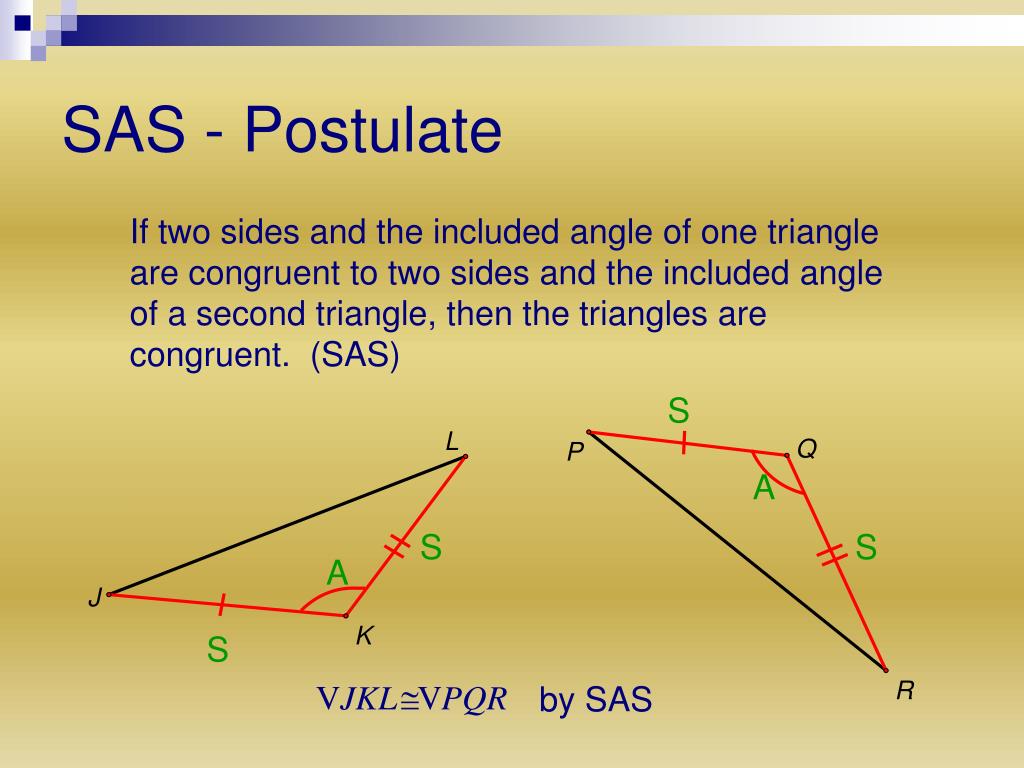

But what if any one angle is given and we have to construct an angle congruent to that? Let's learn it step-wise.
#Congruence postulate definition geometry how to#
Construction of a Congruent Angle to the Given Angleīy now, you have learned about how to construct two congruent angles in geometry with any measurement. This is how we get two congruent angles in geometry, ∠CAB, and ∠RPQ. Step 4- Draw lines that will join AC and PR. Draw that arc and repeat the same process with the same arc by keeping the compass tip on point S. Step 3 - Keep the compass tip on point D and expand the legs of the compass to draw an arc of any suitable length. Draw the arc keeping the lines AB and PQ as the base without changing the width of the compass. Step 2- Take any arc on your compass, less than the length of the lines drawn in the first step, and keep the compass tip at the endpoint of the line. Step 1- Draw two horizontal lines of any suitable length with the help of a pencil and a ruler or a straightedge. Let's learn the construction of two congruent angles step-wise. Construction of a congruent angle to the given angle.Construction of two congruent angles with any measurement.

There are two cases that come up while learning about the construction of congruent angles, and they are: In this section, we will learn how to construct two congruent angles in geometry. ∴ Two angles complementary to the same angle are congruent angles. So, from the above two equations, we get, ∠b ≅ ∠c. We can easily prove this theorem as both the angles formed are right angles. Let us understand it with the help of the image given below. This theorem states that angles that complement the same angle are congruent angles, whether they are adjacent angles or not. Congruent Complements TheoremĬomplementary angles are those whose sum is 90°. ∴ Angles supplement to the same angle are congruent angles. We can prove this theorem by using the linear pair property of angles, as,įrom the above two equations, we get ∠1 = ∠3. This theorem states that angles supplement to the same angle are congruent angles, whether they are adjacent angles or not. Supplementary angles are those whose sum is 180°. Similarly, we can prove the other three pairs of alternate congruent angles too. When a transversal intersects two parallel lines, each pair of alternate angles are congruent. It is always stated as true without proof. It's a postulate so we do not need to prove this. When a transversal intersects two parallel lines, corresponding angles are always congruent to each other. The corresponding angles definition tells us that when two parallel lines are intersected by a third one, the angles that occupy the same relative position at each intersection are known to be corresponding angles to each other. (By eliminating ∠1 on both sides)Ĭonclusion: Vertically opposite angles are always congruent angles. If equals are subtracted from equals, the differences are equal. (Transitive: if a=b and b=c that implies a=c) Quantities equal to the same quantity are equal to each other. We already know that angles on a straight line add up to 180°. Proof: The proof is simple and is based on straight angles.

Statement: Vertical angles are congruent. Vertical Angles TheoremĪccording to the vertical angles theorem, vertical angles are always congruent. Let's understand each of the theorems in detail along with its proof.

Using the congruent angles theorem we can easily find out whether two angles are congruent or not. There are many theorems based on congruent angles.


 0 kommentar(er)
0 kommentar(er)
